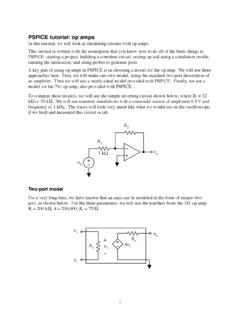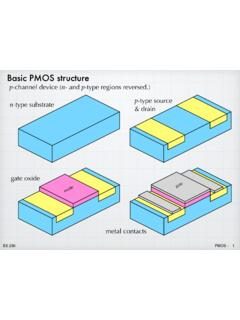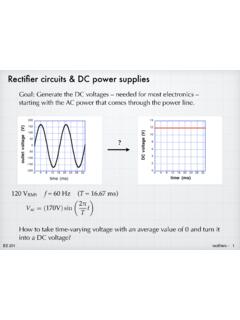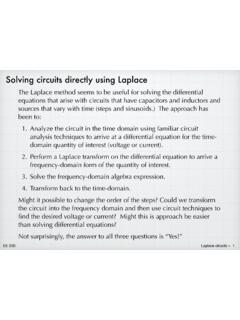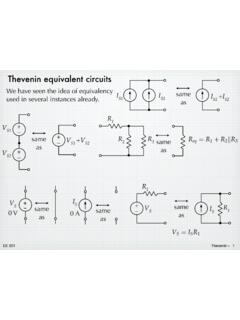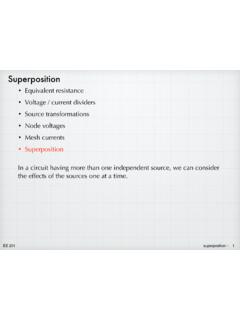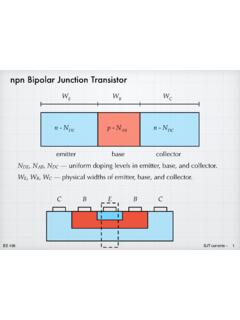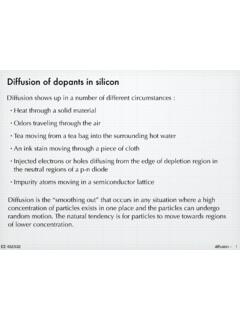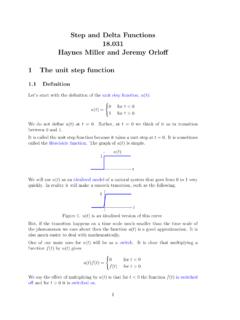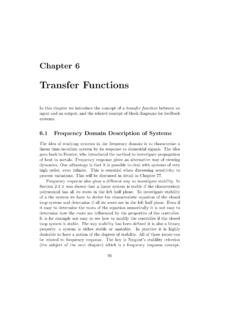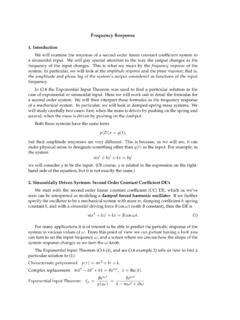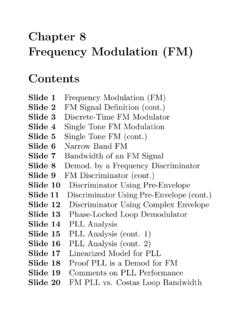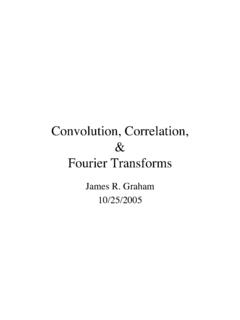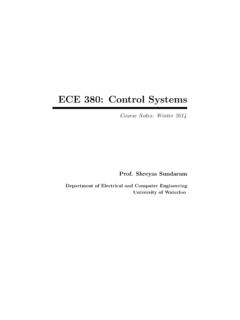Transcription of First-order filters - Iowa State University
1 EE 2301st- order filters 1 First-order filtersThe general form for the transfer function of a first order filter is:T(s)=Go s+Zos+PoThere will always be a single pole at s = Po. The pole must be real (there is only one, so no complex conjugates are not possible) and it must be negative (for stability). There will always be a zero, which can be at s = 0, as s (zero at infinity), or somewhere else, s = Zo. (Note the zero can have a positive value.) There may be a gain factor, Go, which might be 1 or smaller (for a passive circuit with a voltage divider) or have a magnitude greater than 1 for an active circuit. The two most important cases are the zero at infinity, which is a low-pass filter and the zero at zero, which is the high-pass (s)=a1s+a0b1s+boHowever, we will typically recast this into a standard form:EE 2301st- order filters 2 Low-passIn the case were a1 = 0, we have a low-pass (s)=Go Pos+PoT(s)=aob1s+boIn standard form, we write it as: j xpole at P0s-planezero as s The reason for this form will become clear as we proceed.
2 We will ignore the gain initially and focus on sinusoidal behavior by letting s = j .Pos+Pos=j =PoPo+j Re-expressing the complex value in magnitude and phase form:PoPo+j =[PoP2o+ 2]exp(j LP) LP= arctan( Po)EE 2301st- order filters 3By looking at the magnitude expression, we can see the low-pass behavior. For low frequencies ( << Po): . At high frequencies ( >> Po): . At low frequencies, the magnitude is 1 (the output is equal to the input) and at high frequencies, the magnitude goes down inversely with frequency , consistent with the notion of a low-pass response . We can also examine the phase at the extremes. For low frequencies ( 0): . At high frequencies ( + ): .PoP2o+ 2 PoP2o=1 PoP2o+ 2 Po 2=Po LP= arctan( Po) 0 LP= arctan( Po) 90 EE 2301st- order filters 4M=PoP2o+ 2We can use the functions to make the magnitude and phase as frequency response plots.
3 LP= arctan( Po) (dB)-50-40-30-20-10010101001000100001000 00phase ( )-90-75-60-45-30-15010100100010000100000 angular frequency (rad/s)angular frequency (rad/s)angular frequency (rad/s)magnitude - linear scalemagnitude - Bode plotphaseEE 2301st- order filters 5 Use the standard definition for cut-off frequency , which is the frequency at which the magnitude is down by from the value in the pass-band. For our low-pass function, the pass band is at low frequencies, and the magnitude there is 1. (Again, we are hiding Go by assuming that it is unity. If Go 1, then everything is scaled by Go.)2 Cut-off frequencyM=12=PoP2o+ 2cWith a bit of algebra, we find that . The cut-off frequency is defined by the pole. Tricky! Thus, in all of our equations, we could substitute c for Po. c=PoWe can also calculate the phase at the cut-off frequency .
4 LP= arctan( cPo)= 45 The cut-off frequency points are indicated in the plots on the previous 2301st- order filters 6 /3= arctan F 7/3(M )=*R FM + F7/3(V)=*R FV+ F7/3(V)=*R +V F7/3(M )=*R +M F /3= arctan F Again, we could just as easily use real frequency rather than angular frequency . As an exercise: re-express all of the above formulas using f instead of .To emphasize the importance of the corner frequency in the low-pass function, we can express all the previous results using c in place of Po. On the left are the functions in "standard" form. On the right, the functions are expressed in a slightly different form that is sometimes easier to use. 7/3(M ) = *R F + F<latexit sha1_base64="ZcBktQQdyEg5 AHKJu2kZSXSy48k=">AAAC53icbZFBaxNBFMdn16o12prq0ctgEFIsIRsE PSgUFOqhhwhNU8imy+zk7 WbM7Mw681 YSlv0M3sSrH8uLn8 XZJC1J6oOFP7///83svBfnUljsdv94/r29+w8e7j 9qPH5ycPi0efTs0urCcBhwLbW5ipkFKRQMUKCEq9 wAy2 IJw3j2sfaH38 FYodUFLnIYZyxVIhGcoUNRcx7 GIqWhiyC9iMrzfhVKSLD9 NdQZpCw0Ip3icR1aZT7 QjYazSNNbK0wM4+WqjUa8 KkP7zeANuO69prfeda+qomar2+kui94 VwVq0yLr60ZE3 DCeaFxko5 JJZOwq6OY5 LZlBwCVUjLCzkjM9 YCiMnFcvAjsvliCr6ypEJTbRxn0K6pJsdJcusXWS xS2 YMp3bXq+H/vFGBybtxKVReICi+uigpJEVN63nTiT DAUS6cYNwI96+UT5kbFbqtbN2yPDsHvvWScl4owf UEdqjEORrmoAXMmFD1q8o+k26tSt9gd17N259 EKtCenNfmyZkBmB1vZBtuFcHu4O+Ky14n6 HaCL29ap+/XS9knL8hL0iYBeUtOyWfSJwPCyV9vz zvwDn3h//B/+r9 WUd9b9zwnW+X//gdpMOvt</latexit> <latexit sha1_base64="ZcBktQQdyEg5 AHKJu2kZSXSy48k=">AAAC53icbZFBaxNBFMdn16o12prq0ctgEFIsIRsE PSgUFOqhhwhNU8imy+zk7 WbM7Mw681
5 YSlv0M3sSrH8uLn8 XZJC1J6oOFP7///83svBfnUljsdv94/r29+w8e7j 9qPH5ycPi0efTs0urCcBhwLbW5ipkFKRQMUKCEq9 wAy2 IJw3j2sfaH38 FYodUFLnIYZyxVIhGcoUNRcx7 GIqWhiyC9iMrzfhVKSLD9 NdQZpCw0Ip3icR1aZT7 QjYazSNNbK0wM4+WqjUa8 KkP7zeANuO69prfeda+qomar2+kui94 VwVq0yLr60ZE3 DCeaFxko5 JJZOwq6OY5 LZlBwCVUjLCzkjM9 YCiMnFcvAjsvliCr6ypEJTbRxn0K6pJsdJcusXWS xS2 YMp3bXq+H/vFGBybtxKVReICi+uigpJEVN63nTiT DAUS6cYNwI96+UT5kbFbqtbN2yPDsHvvWScl4owf UEdqjEORrmoAXMmFD1q8o+k26tSt9gd17N259 EKtCenNfmyZkBmB1vZBtuFcHu4O+Ky14n6 HaCL29ap+/XS9knL8hL0iYBeUtOyWfSJwPCyV9vz zvwDn3h//B/+r9 WUd9b9zwnW+X//gdpMOvt</latexit> <latexit sha1_base64="ZcBktQQdyEg5 AHKJu2kZSXSy48k=">AAAC53icbZFBaxNBFMdn16o12prq0ctgEFIsIRsE PSgUFOqhhwhNU8imy+zk7 WbM7Mw681 YSlv0M3sSrH8uLn8 XZJC1J6oOFP7///83svBfnUljsdv94/r29+w8e7j 9qPH5ycPi0efTs0urCcBhwLbW5ipkFKRQMUKCEq9 wAy2 IJw3j2sfaH38 FYodUFLnIYZyxVIhGcoUNRcx7 GIqWhiyC9iMrzfhVKSLD9 NdQZpCw0Ip3icR1aZT7 QjYazSNNbK0wM4+WqjUa8 KkP7zeANuO69prfeda+qomar2+kui94 VwVq0yLr60ZE3 DCeaFxko5 JJZOwq6OY5 LZlBwCVUjLCzkjM9 YCiMnFcvAjsvliCr6ypEJTbRxn0K6pJsdJcusXWS xS2 YMp3bXq+H/vFGBybtxKVReICi+uigpJEVN63nTiT DAUS6cYNwI96+UT5kbFbqtbN2yPDsHvvWScl4owf UEdqjEORrmoAXMmFD1q8o+k26tSt9gd17N259 EKtCenNfmyZkBmB1vZBtuFcHu4O+Ky14n6 HaCL29ap+/XS9knL8hL0iYBeUtOyWfSJwPCyV9vz zvwDn3h//B/+r9 WUd9b9zwnW+X//gdpMOvt</latexit> <latexit sha1_base64="ZcBktQQdyEg5 AHKJu2kZSXSy48k=">AAAC53icbZFBaxNBFMdn16o12prq0ctgEFIsIRsE PSgUFOqhhwhNU8imy+zk7 WbM7Mw681 YSlv0M3sSrH8uLn8 XZJC1J6oOFP7///83svBfnUljsdv94/r29+w8e7j 9qPH5ycPi0efTs0urCcBhwLbW5ipkFKRQMUKCEq9 wAy2 IJw3j2sfaH38 FYodUFLnIYZyxVIhGcoUNRcx7 GIqWhiyC9iMrzfhVKSLD9 NdQZpCw0Ip3icR1aZT7 QjYazSNNbK0wM4+WqjUa8 KkP7zeANuO69prfeda+qomar2+kui94 VwVq0yLr60ZE3
6 DCeaFxko5 JJZOwq6OY5 LZlBwCVUjLCzkjM9 YCiMnFcvAjsvliCr6ypEJTbRxn0K6pJsdJcusXWS xS2 YMp3bXq+H/vFGBybtxKVReICi+uigpJEVN63nTiT DAUS6cYNwI96+UT5kbFbqtbN2yPDsHvvWScl4owf UEdqjEORrmoAXMmFD1q8o+k26tSt9gd17N259 EKtCenNfmyZkBmB1vZBtuFcHu4O+Ky14n6 HaCL29ap+/XS9knL8hL0iYBeUtOyWfSJwPCyV9vz zvwDn3h//B/+r9 WUd9b9zwnW+X//gdpMOvt</latexit> 7/3(M ) = *R + F <latexit sha1_base64="tsruQKFNAqMSwf46/a2 GHQ0xhLA=">AAAC8nicbVFNj9 MwEHXC11I+tgsXEBeLCqkrVlWyQoIDSCuBtBz2 UKTt7kpNiRx3kpo6drAnaKsoJ/4FN8 SVP8RP4F/gtAG1 XUay/PTmzRt7 JimksBgEvzz/2vUbN2/t3O7cuXvv/m5378GZ1aXh MOJaanORMAtSKBihQAkXhQGWJxLOk/nbJn/+BYwV Wp3iooBJzjIlUsEZOirufo0 SkdHISZCextXJsI4kpNj/FOkcMhYZkc1wvxGtNG9 olBrGq7Wy41jTf4K6iuxng1X4fOXTqpdmdXvTmNe tMf14 WNdxtxcMgmXQqyBsQY+0 MYz3vPNoqnmZg0 IumbXjMChwUjGDgkuoO1 FpoWB8zjIYO6hYDnZSLadV02eOmdJUG3cU0iW7 XlGx3 NpFnjhlznBmt3MN+b/cuMT01aQSqigRFF81 SktJUdNm9 HQqDHCUCwcYN8K9lfIZc/NBt6 CNLkvvAvjGT6rLUgmup7 DFSrxEwxxpAXMmVPOrasik27 DSf2nn1/D9dyITaA9 OmuTBsQGY769pO24V4fbgr4 Kzw0 EYDMIPL3pHr9ul7 JAn5 Cnpk5C8 JEfkPRmSEeHkt7frPfIe++h/87/7P1ZS32trHpKN 8H/+AUXJ8U8=</latexit> <latexit sha1_base64="tsruQKFNAqMSwf46/a2 GHQ0xhLA=">AAAC8nicbVFNj9 MwEHXC11I+tgsXEBeLCqkrVlWyQoIDSCuBtBz2
7 UKTt7kpNiRx3kpo6drAnaKsoJ/4FN8 SVP8RP4F/gtAG1 XUay/PTmzRt7 JimksBgEvzz/2vUbN2/t3O7cuXvv/m5378GZ1aXh MOJaanORMAtSKBihQAkXhQGWJxLOk/nbJn/+BYwV Wp3iooBJzjIlUsEZOirufo0 SkdHISZCextXJsI4kpNj/FOkcMhYZkc1wvxGtNG9 olBrGq7Wy41jTf4K6iuxng1X4fOXTqpdmdXvTmNe tMf14 WNdxtxcMgmXQqyBsQY+0 MYz3vPNoqnmZg0 IumbXjMChwUjGDgkuoO1 FpoWB8zjIYO6hYDnZSLadV02eOmdJUG3cU0iW7 XlGx3 NpFnjhlznBmt3MN+b/cuMT01aQSqigRFF81 SktJUdNm9 HQqDHCUCwcYN8K9lfIZc/NBt6 CNLkvvAvjGT6rLUgmup7 DFSrxEwxxpAXMmVPOrasik27 DSf2nn1/D9dyITaA9 OmuTBsQGY769pO24V4fbgr4 Kzw0 EYDMIPL3pHr9ul7 JAn5 Cnpk5C8 JEfkPRmSEeHkt7frPfIe++h/87/7P1ZS32trHpKN 8H/+AUXJ8U8=</latexit> <latexit sha1_base64="tsruQKFNAqMSwf46/a2 GHQ0xhLA=">AAAC8nicbVFNj9 MwEHXC11I+tgsXEBeLCqkrVlWyQoIDSCuBtBz2 UKTt7kpNiRx3kpo6drAnaKsoJ/4FN8 SVP8RP4F/gtAG1 XUay/PTmzRt7 JimksBgEvzz/2vUbN2/t3O7cuXvv/m5378GZ1aXh MOJaanORMAtSKBihQAkXhQGWJxLOk/nbJn/+BYwV Wp3iooBJzjIlUsEZOirufo0 SkdHISZCextXJsI4kpNj/FOkcMhYZkc1wvxGtNG9 olBrGq7Wy41jTf4K6iuxng1X4fOXTqpdmdXvTmNe tMf14 WNdxtxcMgmXQqyBsQY+0 MYz3vPNoqnmZg0 IumbXjMChwUjGDgkuoO1 FpoWB8zjIYO6hYDnZSLadV02eOmdJUG3cU0iW7 XlGx3 NpFnjhlznBmt3MN+b/cuMT01aQSqigRFF81 SktJUdNm9 HQqDHCUCwcYN8K9lfIZc/NBt6 CNLkvvAvjGT6rLUgmup7 DFSrxEwxxpAXMmVPOrasik27 DSf2nn1/D9dyITaA9 OmuTBsQGY769pO24V4fbgr4 Kzw0 EYDMIPL3pHr9ul7 JAn5 Cnpk5C8 JEfkPRmSEeHkt7frPfIe++h/87/7P1ZS32trHpKN 8H/+AUXJ8U8=</latexit> <latexit sha1_base64="tsruQKFNAqMSwf46/a2 GHQ0xhLA=">AAAC8nicbVFNj9 MwEHXC11I+tgsXEBeLCqkrVlWyQoIDSCuBtBz2 UKTt7kpNiRx3kpo6drAnaKsoJ/4FN8 SVP8RP4F/gtAG1 XUay/PTmzRt7 JimksBgEvzz/2vUbN2/t3O7cuXvv/m5378GZ1aXh MOJaanORMAtSKBihQAkXhQGWJxLOk/nbJn/+BYwV Wp3iooBJzjIlUsEZOirufo0
8 SkdHISZCextXJsI4kpNj/FOkcMhYZkc1wvxGtNG9 olBrGq7Wy41jTf4K6iuxng1X4fOXTqpdmdXvTmNe tMf14 WNdxtxcMgmXQqyBsQY+0 MYz3vPNoqnmZg0 IumbXjMChwUjGDgkuoO1 FpoWB8zjIYO6hYDnZSLadV02eOmdJUG3cU0iW7 XlGx3 NpFnjhlznBmt3MN+b/cuMT01aQSqigRFF81 SktJUdNm9 HQqDHCUCwcYN8K9lfIZc/NBt6 CNLkvvAvjGT6rLUgmup7 DFSrxEwxxpAXMmVPOrasik27 DSf2nn1/D9dyITaA9 OmuTBsQGY769pO24V4fbgr4 Kzw0 EYDMIPL3pHr9ul7 JAn5 Cnpk5C8 JEfkPRmSEeHkt7frPfIe++h/87/7P1ZS32trHpKN 8H/+AUXJ8U8=</latexit>EE 2301st- order filters 7 Low-pass filter circuits: simple RCUse a voltage divider to find the transfer (V)==&=&+=59L(V)Clearly, this is low-pass with Go = 1 and F= 5& ++ Vi(s)ZR =RVo(s)= V&ZCResistor and capacitor in series output taken across the (V)=9R(V)9L(V)==&=&+=5= V& V&+5= 5&V+ 5&= FV+ FThe only real design consideration is choosing the RC product, which then sets the corner 2301st- order filters 8 Low-pass filter circuits: simple RLUse a voltage divider to find the transfer , low-pass behavior with Go = 1, but now with Inductor and resistor in series output taken across the (V)=9R(V)9L(V)==5=5+=/=55+V/=5/V+5/= FV+ F9R(V)==5=5+=/9L(V) F=5/+ +Vi(s)Vo(s)ZL = sLZR = RAs with the previous example choosing the RL time constant , we can define the pass-band of this low-pass filter.
9 EE 2301st- order filters 9Z1= =5 V&=5 +V5 & +CR1R2Vi(s)Vo(s)7(V)=9R(V)9L(V)= = = = 5 +V5 &5 = 5 5 +V5 &At low frequencies: |T| R2/R1, and T 180 (= 180 )At high frequencies: |T| ( R1C) 1, and T +90 (= 270 )= 5 5 5 &V+ 5 &Clearly, this is also low-pass with and *R= 5 5 F= 5 &Be careful with the extra negative sign in the gain: 1 = exp( j180 )Low-pass filter circuits: inverting op ampEE 2301st- order filters 10 Magnitude and phase plots for an active low-pass filter with R1 = 1 k , R2 = 25 k , and C = nF, giving fo = 1000 Hz and Go = 25 (|Go|= 28 dB).EE 2301st- order filters 11 +RCVo(s)Vi(s)R1R2 Low-pass filter circuits: non-inverting op ampNote: It might slightly disingenuous to treat this as if it were some new type of filter we can readily see that it is a simple RC filter cascaded with a simple non-inverting amp.
10 However, it is still a useful +(V)==&=&+=5= 5&V+ 5&9R(V)= +5 5 9+(V)non-inverting ampsimple RCLow-pass with and *R= +5 5 F= 5&7(V)=9R(V)9L(V)= +5 5 5&V+ 5& EE 2301st- order filters 12 Low-pass filter circuits: another RC ++ Vi(s)ZR1 = R1Vo(s)= V&ZCZR2 = R2=3==5 =&=5 V& 5 + V&=5 +V5 &7(V)=9R(V)9L(V)==3=3+=5 =5 +V5 &5 +V5 &+5 =5 5 +5 +V5 5 &= 5 5 +5 53&V+ 53&=*R FV+ F53=5 5 *R=5 5 +5 Note the voltage divider. Gain < 1. F= 53& corner depends on the parallel 2301st- order filters 13 High-passIn the case were a0 = 0, we have a high-pass (s)=Go ss+PoT(s)=a1sb1s+boIn standard form, we write it as:We will ignore the gain initially (set Go = 1) and focus on sinusoidal behavior by letting s = j .ss+Pos=j =j Po+j Re-expressing the complex value in magnitude and phase form:j Po+j =[ P2o+ 2]exp(j HP) HP=90 arctan( Po) j xpole at P0s-planezero at 0EE 2301st- order filters 14By looking at the magnitude expression, we can see the high-pass behavior.
